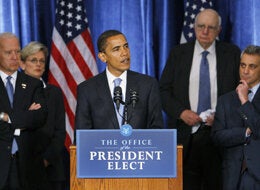
All indications are that our new President has in mind a "New Deal" when it comes to Presidential communications. He certainly knows his way around the technology. He fought with government lawyers and security agencies to keep his own BlackBerry for personal and private messages. He welcomes opportunities to meet the press. His rhetorical flair and unflappable confidence on the platform catapulted him onto the national stage four years ago; he just kept getting better. It isn't all about style -- it's the way he thinks about communication. Running a tight campaign ship (No Drama Obama) set a pattern that most expect will continue in the Oval Office. Mr. Obama even created something heretofore unheard of -- the office of the President-Elect -- complete with a media room and a presidential-worthy podium. As Gerald Seib, Capital Journal columnist for the Wall Street Journal observed, our Commander in Chief apparently intends also to become a "Communicator-in-Chief."
It would be easy to pigeonhole Barack Obama's style as charismatic. He certainly commands the room, no matter the venue, and connects with audiences in every situation. He adapts with ease -- a comfortable, conversational, hipster, down-home style for a reporter sit-down, which contrasts with his confident, motivational way of delivering the rhetoric of hope on the platform. He does have some annoying vocal habits -- I noticed after awhile that the phrases "as I've said," or "I've made it clear," frequently crept in, just prior to the answer to a tough question. Still, you cannot help but admire the way he can work a crowd into an absolute frenzy.
Having said all that, there is certainly more to Obama's effectiveness than charisma. The fact that he has carved out so much precious time for press conferences during the transition is an indication of how he sees his role. It isn't just his relationship with the press -- it's the overall message that communication and leadership are one. Sure, he always prefaced remarks on policy and news events by saying we still have one President at a time, and yet, by becoming so highly visible, Obama gained control of the national dialogue, anyway, filling the potential news vacuum during the Bush to Obama transition. Had Mr. Obama chosen to stay behind the scenes, the nation would not necessarily have expected him to be out there, but it would have made us feel restless and leaderless. Instead, there was this perception that someone was already in charge.
What can leaders learn from Barack Obama's approach to communication? It really isn't about style. Every leader has to develop his or her own style, from interpersonal to platform skills. You find a way of communicating with people that is honest, effective, and authentic to you. The real takeaway from watching Mr. Obama begin his presidency is that in challenging times, leaders know that communication is everything. Sheperding your organization through the turmoil our economic meltdown requires you to put yourself at the center of the communication universe. You cannot view the communication "function" as such -- something that "other people" manage and execute. You have to stand right there and make sure it happens -- position yourself in the middle of the loop.
This can be difficult on a personal level. It's hard to communicate when you don't have the answers. In times of stress we are inclined to retreat and wait. If you don't feel like you have something good to say, perhaps you think you should say nothing at all. Yet what is really required -- is a full court press. You have to communicate more often, with greater purpose and passion than ever before. While you don't have all the answers, you get an honest, open, creative dialogue goiung with your employees and customers, and keep it going. You look for real signs of progress and give them hope.
People are comparing Obama to FDR, Winston Churchill, Martin Luther King Jr., John F. Kennedy, and Ronald Reagan, and these comparisons are real and noteworthy. These were leaders who made people believe. They didn't come by it naturally -- Martin Luther King was a mediocre speaker who aspired to be great; Reagan fashioned his style in Hollywood; Winston Churchill practiced his speeches incessantly. All knew the importance of honing their skills to becoming great leaders. In addition they surrounded themselves with people who could help them - they hired great speechwriters who employed writing techniques such as parallel structure ("I have a dream", "Ask not what your country can do . . . ") and they practiced over many years to develop a highly effective style, using pace, pauses, and timing.
So leadership and communication go hand in hand, and in challenges times, you have to deliver a message of hope. You must motivate and inspire people by communicating with purpose and passion at every opportunity. Connecting people with a message of hope may be the highest definition of leadership. As a leader, you can change the course of your business by making people believe in themselves. People who are motivated and inspired will overcome the obstacles, defy the odds and accomplish more. And this will have a direct, undeniable impact on the bottom line of your business, and the future of your company.
What is the leader's challenge? It is to recognize first that you are the Communicator-in Chief. You must clearly communicate the mission, purpose and plan so that it inspires people. This allows them to connect with their own sense of purpose, to be a part of the solution. Just as Barack Obama intends to harness the power of communication to spark creativity, ingenuity and purpose, so too, must business leaders set this intention.